shanegalang
Bronze Member
I found a "rock" with my metal detector. For it's size it is like 5 times heavier than a rock. I began reading different sites about how to tell if it's a meteorite. It seems to be one as far as I can tell except its not magnetic. Also i took a small piece of brass that wouldnt stick to a magnet yet the small piece of brass sticks to this "rock". Has anyone ever seen a metal that has these properties? What could it be? Thanks. I will post pictures tonight when I get to my laptop I am using a hotel PC. The object is about 1 inch X 1 inch X 3/4 in. and weighs 88.8 grams on a digital scale. It has a bit of a black coating. I scrubbed it some with a tooth brush and it glitters a gold color. Thanks for any suggestions.
Updated with pictures:
I reduced the picture size so you can see the brass piece that wont stick to a magnet yet does to this. I have never seen brass attracted to anything. I am stumped.
Updated with pictures:
I reduced the picture size so you can see the brass piece that wont stick to a magnet yet does to this. I have never seen brass attracted to anything. I am stumped.





 But still a very odd chunk of something that shouldn't be in a sugar cane field in South Louisiana. She thinks it is Zinc sulfide. Any ideas why that would be where it was? I am open to suggestions, she asked if I wanted to pursue it farther. I said I would come pick it up. What should I do at this point? Could it be part of a satellite? Space Shuttle Columbia?? Thanks for any suggestions, Shane
But still a very odd chunk of something that shouldn't be in a sugar cane field in South Louisiana. She thinks it is Zinc sulfide. Any ideas why that would be where it was? I am open to suggestions, she asked if I wanted to pursue it farther. I said I would come pick it up. What should I do at this point? Could it be part of a satellite? Space Shuttle Columbia?? Thanks for any suggestions, Shane


